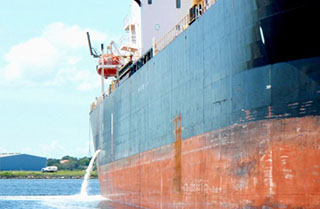Congress should act this year to replace a “regulatory patchwork” of federal and state ballast water regulations with unified, scientifically based standards, industry advocates told a Congressional subcommittee reviewing maritime transport programs.
Experts testifying at the House Subcommittee on Coast Guard and Maritime Transportation gave praise and general high marks for Coast Guard programs like the coming Subchapter M suite of regulations for towing vessels. But the April 14 session on Capitol Hill was notable for critiques of ballast water regulations, with subcommittee chair Rep. Duncan Hunter, R-Calif., expressing “ongoing frustration” with contradictory Coast Guard and Environmental Protection Agency requirements.
While the Coast Guard is allowing vessel operators breathing space while new treatment methods are developed and tested, “the EPA provides no mechanism for an extension…this blows my mind,” said Hunter, a primary sponsor of bill H.R. 980, the “Vessel Incidental Discharge Act.”
Meanwhile, continuing debate over measuring the efficacy of ballast water treatment systems effectively means “let’s dump dirty water rather than take an 80% solution,” and operators also contend with 25 other state and local jurisdictions with their own rules, Hunter said.
Some 19 treatment methods, nine of them utilizing ultraviolet light to eliminate marine organisms from ballast water, are undergoing testing, said Rear Adm. Paul Thomas, Coast Guard deputy commandant for prevention policy.
In a lengthy question and answer exchange with Hunter, Thomas defended the Coast Guard position that the most reliable testing of treatment efficacy is the measure of organisms alive vs. dead – “How many critters can be in how much volume of water.” Under international maritime convention, “it requires us to set a standard based on best available technology,” Thomas said.
“Do you want to murder these critters, or just render them harmless?” Hunter asked. He cited regulatory language defining treatment that can “kill, render harmless, or remove” organisms from ballast water.
“The trick comes in developing the tests,” Thomas replied. He left a door open to the possibility of the so-called viability test – measuring treatment systems that sterilize organisms not killed outright – if the Coast Guard can find a reliable, repeatable test method.
“There is a reliable repeatable efficacy test to determine if something is dead,” Thomas said. “There is not a reliable repeatable efficacy test to determine if they have been rendered harmless.”
While that technical debate continues, other players are potentially making ballast water management more chaotic, warned Tom Allegretti, president and CEO of The American Waterways Operators. The industry is not trying to avoid high standards, but needs more order amid some 150 different federal, state and local rules, he said.
“Right now, given the uncertainty caused by this regulatory patchwork, one of the riskiest decisions AWO members have to make when constructing or overhauling a vessel is investing in an onboard ballast water treatment system,” Allegretti said.
“Despite overwhelming scientific evidence demonstrating that the federal ballast water treatment standard is the most protective that is currently achievable, California elected to set a significantly higher standard, a choice that has consistently proven infeasible because the state’s own enforcement agency has concluded that commercially available ballast water treatment systems do not exist to allow vessel owners to meet state law,” he said.
California’s delays in implementing its rule means companies that install federally compliant treatment systems in their vessels must “wait in suspense to see whether California will compel them to replace their equipment or move the goalposts further downfield,” Allegretti said.
On top of that, a 2015 decision by the U.S. Court of Appeals for the Second Circuit requires the EPA to reassess its treatment standard, raising the possibility that the agency and Coast Guard rules could diverge even farther.
“Let me be clear: the Second Circuit remand is a potential game-changer. An EPA ballast water treatment standard that deviates from the Coast Guard’s would worsen an already untenable regulatory situation,” he said, calling for passage of H.R. 980.





